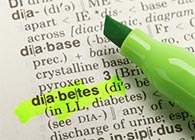Loss of Warnings or Hypoglycaemia Unawareness
Loss of Warnings or Hypoglycaemia Unawareness
Hypoglycaemia itself, or the avoidance of it, is an acute daily problem for people with diabetes but when accompanied by loss or partial loss of warnings, it can have a dramatic effect on the lives of both the person with diabetes and their families. There can be a marked reduction in the quality of life for all concerned.
Total loss of warnings – A condition where the warning symptoms of an impending hypo are not present and so when the blood glucose levels drop there are no warning signs that the person must eat. This makes the likelihood of severe hypos much greater. People with loss of warnings have to rely on the help of others and frequent blood glucose monitoring.
Partial loss of hypo warnings – This means that warning symptoms are present sometimes and not at other times. In some ways this is more difficult than total loss of warnings because the person may not even be aware that they have some loss of warnings and so have unexpected and unheralded moderate or severe hypos. This is particularly dangerous when driving.
Reduced warning symptoms – Is where the early warning signs of hypoglycaemia are reduced or missing [sweating, trembling etc] and the blood glucose drops to the stage where the symptoms are less obvious [confusion, behavioural changes etc]. This means that the person often then requires the help of others to treat the hypo.
The effects of loss of warnings
Information gathered from the experiences of people with diabetes and their carers says that loss of warnings may result in the following:
- A feeling of insecurity and loss of independence
- Embarrassment
- A fear of leaving the home
- Being a danger to oneself and others
- Aggressive or violent behaviour
- Family conflict, breakdown of relationships
- Loss of driving licence – it is illegal to drive with loss of warnings
- Loss of job
- A deliberate raising of blood glucose levels to avoid such situations
Causes of loss of warnings or hypo unawareness
There are several known causes of loss of awareness of hypoglycaemia:
- Duration of diabetes – long term diabetes can result in loss of warnings.
- Hypoglycaemia itself can cause loss of warnings and therefore increase the risk of more hypos. This then becomes a vicious circle of hypos leading to loss of warnings and more hypos!
- Intensive therapy with multi-daily insulin injections and aiming for near normal blood glucose levels, has been shown to cause a threefold increase in the risk of severe hypoglycaemia. This increased hypoglycaemia can therefore increase the risk of loss of warnings.
- Neuropathy – damage to the autonomic nervous system is a complication of diabetes and this can cause loss of warning symptoms.
- Changing insulin species can cause a loss or change in warning symptoms.
- ‘Human’ insulin can cause loss of warnings of hypoglycaemia. This is often not readily admitted by many health professionals but since the early 1990s, Patient Information Leaflets in ‘human’ insulin packs have included a warning of that ‘human’ insulin can cause changed or loss of warnings of an impending hypo.




































